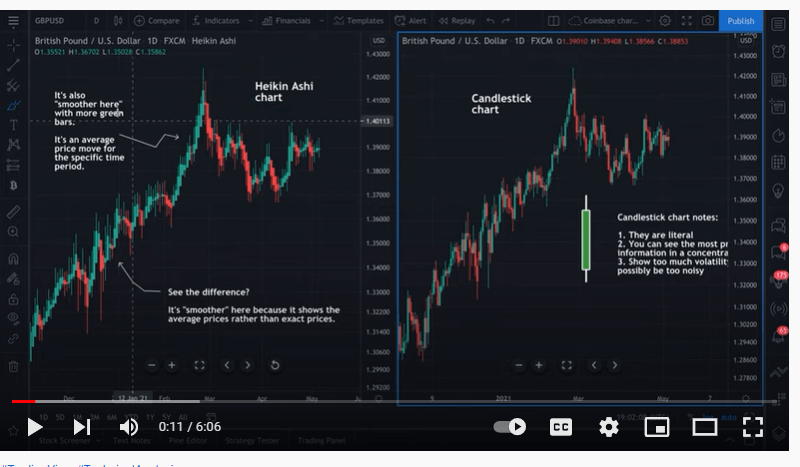
Every forex trader or crypto investor on a trading platform such as Margex aims to make profitable trades. No matter the asset, you must use the Heiken Ashi candlestick chart or other technical analysis tools to identify trends.
An asset price can start a bearish trend now and later reverse negatively. That’s why you analyze trends using technical indicators before making trading decisions. This is where candlestick patterns come into play.
This article is a Heikin Ashi vs. Candle comparison guide exploring the best candlestick charts for traders. Notably, both the Ashi charts and the Japanese candlestick are used in day trading. But which chart can you use to cancel market noise and identify trends for a profitable trade?
Are the traditional Japanese candlesticks better than heikin ashi chart display? Keep reading to know more below. Also, we’ll exemplify how to calculate heikin ashi and use it in a trade.
Understanding The Heikin-Ashi Candlestick – A Typical Candlestick?
The Heikin-Ashi is a candlestick pattern that focuses on the direction of a trend (uptrend, downtrend, sideways trend). The word Heikin-Ashi is a Japanese word translated as “average bar.”
It works for forex, crypto trading, stocks, and the commodity market. This Heiken-Ashi chart was created by Munehisa Homma. He also created the normal candlestick chart for the rice trade in Japan in the 1700s.
The major difference between Heikin-Ashi candlesticks and regular candlesticks is the values used to create the Heikin-Ashi. Traditional candlesticks use the open, high, low, and close prices of a particular timeframe.

Heikin-Ashi, on the other hand, was created using the Heikin Ashi formula based on two-period averages. This approach focuses on averages and does not go entirely into detail, losing some price data.
Traders use these candlestick patterns mainly for technical analysis needed before making moves.
Why Use Heikin-Ashi Vs. Candles
Heikin Ashi charts are quite similar to Japanese candlesticks, but they offer more benefits, especially in terms of presenting trends and calculating asset prices. See Heiken Ashi candlesticks benefits below.
Strength Measurement
The Heikin Ashi candles are relevant in measuring the strength of price movements in the market. How?
The Heikin Ashi candle closing prices do not display shadows during strong up and downtrends. This is mainly because the closing price is the average of the close, low, high, and open.
This function makes it easy for users to analyze trends, which is crucial to making market profits.
Smoothing Effect of Prices
It’s easy to get a smoothing effect of price on the market charts using the Heikin Ashi candles. This is due to the clear representation of opening and closing prices.
Several trend-following traders benefit a lot from this advantage. This is because the Heikin Ashi charts help to smoothen out the market noise and price-action in the markets. The smoothing effect is also relevant as it makes the chart quite comprehensive.
But this feature is not available to traders who use the traditional Japanese candlesticks charts.
How To Calculate Price Movements With Heikin Ashi Candles
Traditional Japanese candlestick charts carry information on the open, high, low, and close prices within a period. However, the Heikin-Ashi also carries price information from the past.
Every candle has four major components: the opening price, the closing price, and the highest and lowest price of a particular period.
There are also four parts to consider when calculating the Heikin Ashi formula:
1) The Open
The Open of the Heikin Ashi candlestick is always calculated from the midpoint of the previous candlestick.
The formula for open is:
Open = (Open price of the previous candle + Close price of the previous candle) /2
2) The Close
The close value of each Heikin Ashi candlestick is obtained from the average value of the Open, Close, high, and low.
Mathematically, it can be calculated with the formula
Close = (Open + High + Low + Close) /4
3) The High
The high of the Ashi candlestick is the same as the actual high of a given period. For example, it could be the highest shadow, the open, or the close. Whichever value is highest at that time.
High = Maximum price attained
4) The Low
Just like the high, the Low of the Heikin Ashi candle is the value of the actual low of the period. It could represent the lowest shadow, the open, or the close. Whichever of these has the lowest value.
Low = Minimum price reached
These formulas will work on different time frames on a chart. In summary, the Heiken Ashi formula is represented below:
High = Maximum of high (Highest high)
Low = Minimum of low (Lowest low)
Open = (open of previous candle + close of previous candle) /2
Close = (Open + High + Low + Close) / 4

Heiken-Ashi Vs. Candlesticks, Which Is Better
When comparing heikin ashi vs. candles, it’s clear that both have some similarities. They use the same coloration for their bullish and bearish trends. While the uptrend, you will see white or green candles, and on the downtrend goes black or red candles.
Despite the slight similarities, the Heiken-Ashi candlestick charts are different from the charts of the regular candlestick. The main difference lies in the formula for calculating the two charts. A standard candlestick chart formula follows the Open-High-Low-Close (OHLC) series. But for a Heiken-Ashi chart, the formula follows the COHL series.
The significance of the formula for a Heiken-Ashi candlestick chart is below:
- Close – This is a quarter of the sum of Open, high, low, and close price bars.
- Open – This is half the sum of the open and close of the previous bars.
- High – This is a peak of the high, open, and close price bars.
- Low – This is a minimum of the low, open, and close price bars.
Comparing a heikin-ashi chart and a traditional candlestick chart
Analyzing their respective charts will give a better understanding of the difference between Heiken-Ashi and traditional candlesticks.

The left chart is a Heiken-Ashi candlestick display, while the right one is a regular candlestick chart.
Just like the Japanese meaning for Heiken-Ashi is ‘average bar,’ price calculations on the Heiken-Ashi chart from average prices. This is unlike the regular candlestick charts, where calculations center on exact prices. Hence, the candle bars in a Heiken-Ashi chart are smoother.
Moreover, displayed prices on a Heiken-Ashi chart may differ from the underlying asset’s actual price. The difference is because calculations of Heiken-Ashi candlesticks focus on average prices.
Hence, most Heiken-Ashi candlestick charts have two prices; the calculated price and the real price. But a regular candlestick will always have the current price of the asset.
Also, the candlesticks in a Heiken-Ashi chart maintain consistency in their color for all candlestick patterns. So, red or black is consistent for a downtrend, while green or white is consistent for an uptrend.
But the charts of normal candlesticks can alternate colors between red and green or black and white, even while the trend is in one direction.
Trade With Heikin-Ashi On Margex
Margex is a crypto derivative platform to trade BTC, ETH, LTC, XRP, EOS, ADA, UNI, and SOL with 100x leverage. It recently launched Staking for Oracle’s followers, a revolutionary feature that allows users to trade with staked assets to earn 8.8% APY on stablecoins and 5.5% APY on Bitcoin.
You can make deposits with BTC, ETH, USDC, DAI, LINK, USDP, wBTC – ERC20, USDT – ERC20, and TRC20, besides credit/debit cards.
Moreover, all crypto assets on Margex, including BTC, USDT, USDC, DAI, ETH, Link, wBTC, and USDP, can be used as trading collaterals. You can start trading on Margex with Heikin achi candles and other indicators, as shown below. All you need is the Margex responsive and well-equipped mobile app.
How to trade on Margex with heikin ashi
The Heikin -Ashi can be used to predict market movement and changes in trends. The key thing is understanding the way the candles work before placing trades.
1. Green candlesticks are the signal for an uptrend
A change from the red candle (bearish) to the green (bullish) signals a bullish run in the market.
2. Green candlesticks with no lower wick/shadow show a strong uptrend.
3. Candlesticks with small bodies showing upper and lower shadows signal a possible trend reversal.
4. Red candlesticks signal a possible downtrend.
5. Red candlesticks with no upper shadow/wick indicate a possibly strong downtrend.
How to Start Trading
- Sign up to our platform and start trading today.

- A confirmation e-mail and code will be sent to your inbox. Follow the link and complete the process.

- After the successful sign-up, you will be directed to this platform. Click on candles, and change to Heikin-Ashi.

- The candles will change to look like this.

- Click on the buy or sell icon to place a trade.

- Your trades will be displayed in the lower part of the Margex trading chart.
With these steps, you can easily place a trade after you fund your account.
Applying A Technical Indicator With Heikin-Ashi On Margex Examples
Heiken-Ashi candles can be used with a couple of indicators for best results.

For the Bollinger bands indicator, in a downward trend, the candle will remain at the lower bands and move to the upper bands in an upward trend. A repetition of consecutive-colored candles signals a bearish or bullish trend, depending on the color.
You can easily select the best indicators on our platform with a button.
Which indicator on Margex works best with Heiken Ashi?
Most times, the best indicators to use are down to personal preference. However, the recommended ones are Bollinger bands, moving averages, and Relative Strength Index (RSI).
Summary Of Heikin Ashi Vs. Candles
The Heiken Ashi technique is used to take advantage of market trends. However, a typical candlestick reading might not be enough to make a sound technical analysis. An informed decision must be made with previous price data to analyze trends properly.Profitable trades can be made by determining the best entry and exit points in a trading session. Heiken-Ashi uses a modified formula to identify trends and take advantage of price movements. It is advisable to use it with other technical indicators.


